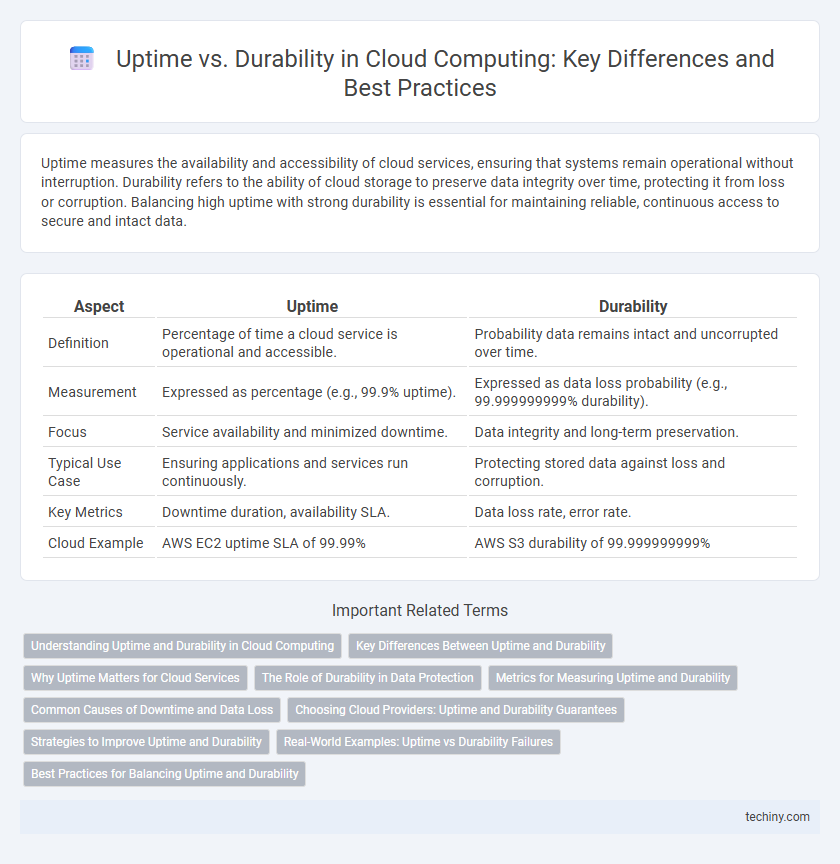Uptime measures the availability and accessibility of cloud services, ensuring that systems remain operational without interruption. Durability refers to the ability of cloud storage to preserve data integrity over time, protecting it from loss or corruption. Balancing high uptime with strong durability is essential for maintaining reliable, continuous access to secure and intact data.
Table of Comparison
| Aspect | Uptime | Durability |
|---|---|---|
| Definition | Percentage of time a cloud service is operational and accessible. | Probability data remains intact and uncorrupted over time. |
| Measurement | Expressed as percentage (e.g., 99.9% uptime). | Expressed as data loss probability (e.g., 99.999999999% durability). |
| Focus | Service availability and minimized downtime. | Data integrity and long-term preservation. |
| Typical Use Case | Ensuring applications and services run continuously. | Protecting stored data against loss and corruption. |
| Key Metrics | Downtime duration, availability SLA. | Data loss rate, error rate. |
| Cloud Example | AWS EC2 uptime SLA of 99.99% | AWS S3 durability of 99.999999999% |
Understanding Uptime and Durability in Cloud Computing
Uptime in cloud computing measures the percentage of time a service remains operational and accessible, often reflected in service level agreements (SLAs) with targets like 99.9% or higher. Durability refers to the guarantee that data stored in the cloud will not be lost or corrupted over time, commonly expressed as an annual durability rate such as 99.999999999% (11 nines) provided by leading cloud storage services. Understanding the distinction between uptime, which impacts availability, and durability, which ensures data integrity, is critical for designing resilient and reliable cloud architectures.
Key Differences Between Uptime and Durability
Uptime measures the percentage of time a cloud service is operational and accessible, reflecting service availability and responsiveness, while durability refers to the likelihood of data remaining intact and uncorrupted over time. High uptime ensures continuous access to applications and services, whereas high durability guarantees long-term data preservation despite hardware failures or data corruption. Cloud providers often use redundancy and error-correction techniques to maximize both uptime and durability, but their metrics address distinct aspects of reliability in cloud computing environments.
Why Uptime Matters for Cloud Services
Uptime is critical for cloud services because it ensures continuous availability and reliable access to applications and data, minimizing downtime that can disrupt business operations and lead to revenue loss. High uptime guarantees that end-users experience consistent performance without interruptions, which is essential for maintaining trust and customer satisfaction. Cloud providers often commit to uptime SLAs (Service Level Agreements) of 99.9% or higher to demonstrate their capability to deliver resilient infrastructure and seamless service continuity.
The Role of Durability in Data Protection
Durability in cloud computing ensures that data remains intact and uncorrupted over time despite hardware failures or system errors, typically measured by the number of nines in data durability percentages (e.g., 99.999999999%). While uptime refers to the availability of cloud services to users, durability focuses on the long-term preservation of data against loss or degradation. Cloud providers implement durability through redundant storage architectures, frequent data integrity checks, and geo-replication to guarantee reliable data protection.
Metrics for Measuring Uptime and Durability
Uptime measures the percentage of time a cloud service remains operational and accessible, typically expressed as a service level agreement (SLA) metric like 99.9% (three nines) or 99.999% (five nines). Durability quantifies the likelihood of data loss over time, often represented by metrics such as annual failure rates or the number of nines indicating data retention, for example, 99.999999999% (11 nines) durability. Key metrics for uptime include mean time between failures (MTBF) and mean time to recovery (MTTR), while durability metrics focus on data replication strategies and error correction through redundancy and versioning.
Common Causes of Downtime and Data Loss
Common causes of downtime in cloud computing include hardware failures, network outages, software bugs, and cyberattacks, all of which disrupt service availability and impact uptime. Data loss often results from hardware corruption, accidental deletion, ransomware attacks, and inadequate backup strategies, threatening data durability. Effective cloud architectures prioritize redundancy, automated failover, and regular backups to mitigate these risks and ensure continuous service and data preservation.
Choosing Cloud Providers: Uptime and Durability Guarantees
When choosing cloud providers, prioritize uptime guarantees to ensure consistent service availability, typically expressed as a percentage such as 99.9% or 99.99%. Durability guarantees, often cited as 99.999999999% (11 nines), are critical for data integrity, ensuring stored data remains intact and uncorrupted over time. Evaluating both uptime SLAs and durability metrics is essential for maintaining reliable cloud infrastructure and safeguarding critical business data.
Strategies to Improve Uptime and Durability
Improving cloud uptime involves implementing robust redundancy protocols, such as multi-region deployment and failover systems, to minimize service interruptions. Enhancing durability requires advanced data replication strategies, including synchronous and asynchronous backups across diverse geographic locations to prevent data loss. Regular testing of disaster recovery plans and continuous monitoring of system health are essential to maintain optimal uptime and data durability in cloud environments.
Real-World Examples: Uptime vs Durability Failures
Amazon S3 exemplifies durability success with its designed 99.999999999% data durability, protecting user data against hardware failures, while occasional service outages impact uptime, as seen in AWS downtime events affecting connectivity but not data loss. Conversely, traditional web hosting services may boast high uptime with 99.99% availability but lack comparable data durability, risking data corruption or loss during hardware failures. Real-world cases highlight that cloud providers prioritize durable storage to prevent data loss even if uptime temporarily degrades, underscoring the distinction between service availability and data integrity guarantees.
Best Practices for Balancing Uptime and Durability
To balance uptime and durability effectively, implement redundant systems and regular automated backups to ensure data remains intact during failures while minimizing downtime. Use geographically distributed data centers to enhance durability without compromising service availability. Continuously monitor system health and perform predictive maintenance to proactively address potential issues, optimizing both uptime and data integrity.
Uptime vs Durability Infographic

 techiny.com
techiny.com